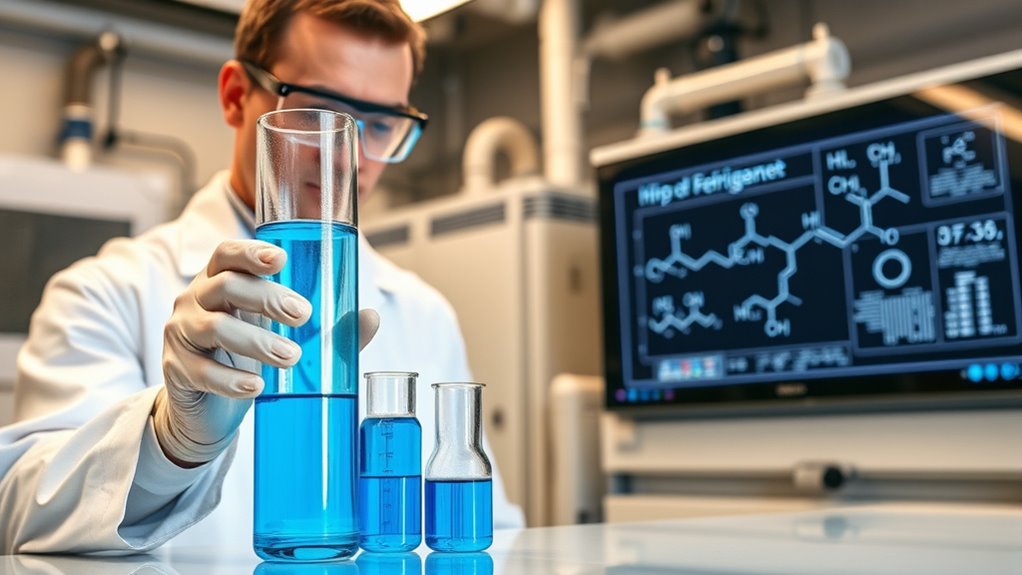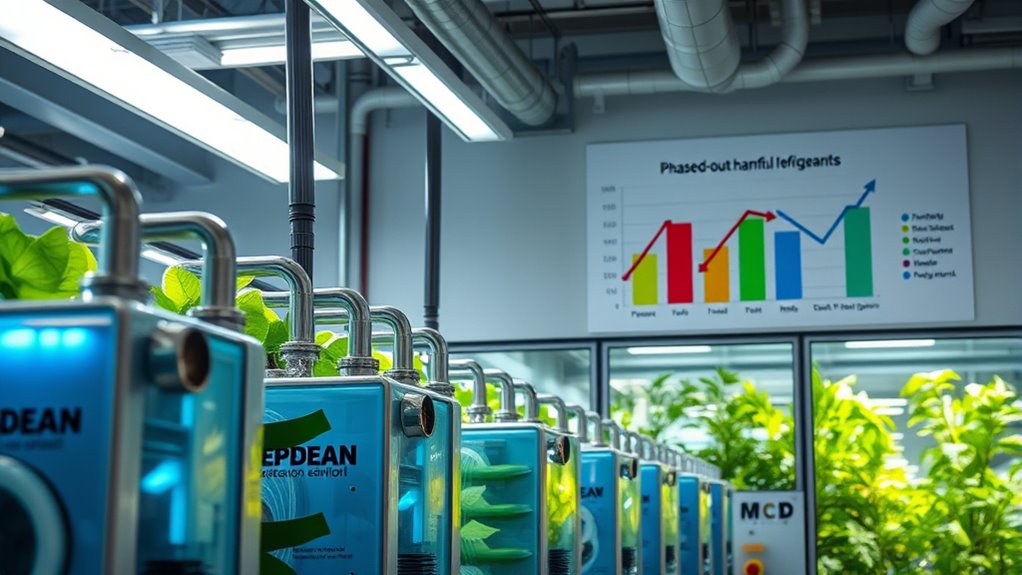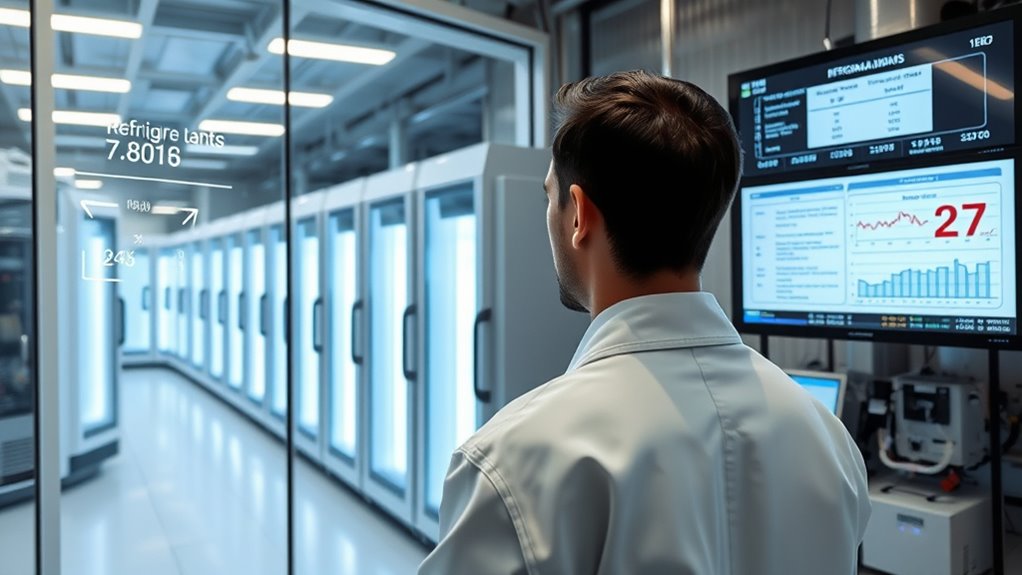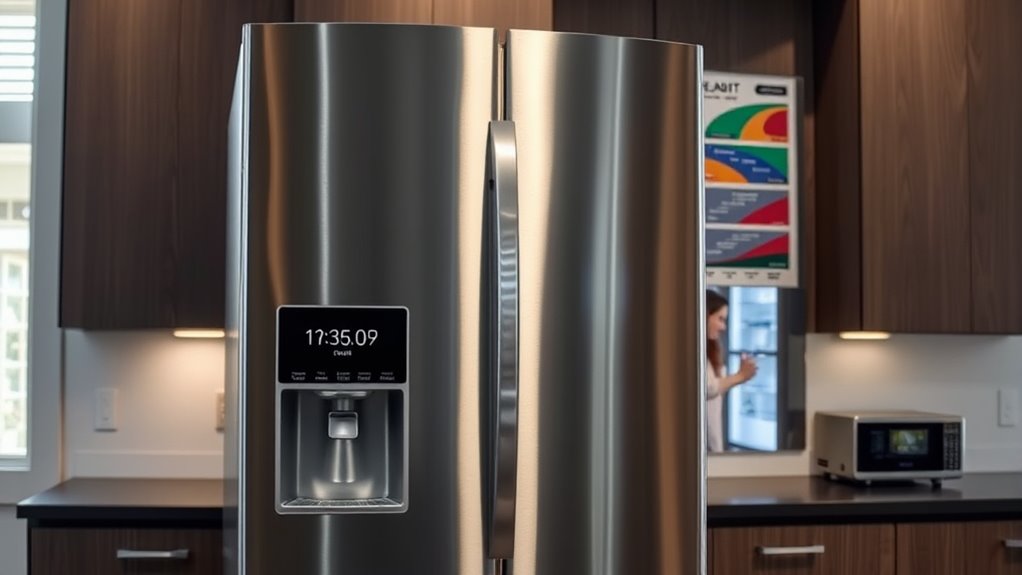Refrigerant phase-outs have shifted industry practices from harmful chemicals like CFCs to safer, eco-friendly options such as HFCs, hydrocarbons, and CO2. This change is driven by environmental concerns, regulations, and the need for energy efficiency. As standards tighten, appliances may need updates to maintain performance, affecting consumers and repairs. Understanding these shifts helps you stay informed about future sustainable solutions—continue exploring to learn more about the evolving refrigerant landscape.
Key Takeaways
- Phasing out harmful refrigerants like CFCs and HCFCs reduces environmental damage and promotes safer, eco-friendly alternatives.
- Regulatory standards enforce strict timelines and emission limits, influencing industry practices and technology updates.
- Transition impacts include potential changes in appliance efficiency, performance, and increased maintenance or repair costs.
- Natural refrigerants such as hydrocarbons and CO2 are gaining popularity for their low global warming potential.
- Advances in technology, including leak detection and safety standards, support sustainable refrigerant adoption and environmental protection.
The Evolution of Refrigerants: From CFCs to Modern Alternatives

The evolution of refrigerants reflects a continuous effort to improve safety, efficiency, and environmental impact. You’ve likely heard of CFCs—once common in air conditioning and refrigeration—but these chemicals damaging the ozone layer. As scientists discovered their harmful effects, regulations phased them out, prompting the search for alternatives. The next step involved HCFCs, which were less damaging but still posed environmental risks. Today, you encounter modern refrigerants like HFCs and natural options such as hydrocarbons and CO2. These newer compounds aim to reduce ozone depletion and global warming potential. This progression shows a clear trend: prioritizing safety, sustainability, and performance. As technology advances, refrigerants continue evolving to meet stricter standards and minimize their impact on the planet. Understanding refrigerant advancements helps consumers and industry professionals make informed decisions about environmentally responsible cooling solutions. Incorporating eco-friendly refrigerants is becoming more common as the industry shifts toward sustainable practices. Additionally, advances in refrigerant technology are enabling more energy-efficient and environmentally conscious cooling systems.
Reasons Driving the Shift Away From Harmful Chemicals

Growing environmental concerns and health risks have driven the push to eliminate harmful chemicals from refrigerants. These substances, like CFCs and HCFCs, damage the ozone layer and contribute to global warming. Regulations now prioritize safer alternatives to protect both the planet and public health. Promoting awareness about refrigerant safety is essential for industry compliance and environmental preservation. Additionally, understanding hackathon opportunities can foster innovative solutions for sustainable refrigerant technologies. Recognizing the importance of environmental impact helps guide the development of eco-friendly refrigerant options.
How Phase-Outs Influence Industry Standards and Regulations

As industries shift away from harmful refrigerants like CFCs, HCFCs, and HFCs, regulatory standards and industry practices are evolving rapidly. Governments worldwide are implementing stricter laws to phase out these chemicals, pushing companies to adopt environmentally friendly alternatives. These regulations often set clear timelines, emission limits, and testing requirements, shaping product development and manufacturing processes. Industry standards are also adapting to ensure safety, efficiency, and compliance, prompting updates to equipment design and refrigerant handling procedures. You’ll notice an increased emphasis on refrigerant lifecycle management and reporting. Additionally, the integration of AI in monitoring systems enhances refrigerant management and compliance tracking. This shift also influences the availability of popular juice brands and other consumer products, as manufacturers seek environmentally responsible solutions. A focus on refrigerant phase-out strategies drives innovation across industries, encouraging the development of more sustainable technologies. Furthermore, understanding the 16PF personality traits of industry stakeholders can facilitate better communication and implementation of new standards. Staying informed about evolving regulatory standards helps you guarantee compliance, avoid penalties, and contribute to sustainable industry practices.
Impacts on Consumers and Appliance Performance

Although refrigerant phase-outs aim to protect the environment, they can also directly affect your everyday appliances’ performance and reliability. As older refrigerants are phased out, manufacturers switch to new ones, which may require adjustments in appliance design. This changeover can lead to variations in cooling efficiency, potentially causing your refrigerator or air conditioner to use more energy or perform less effectively. Some appliances might experience reduced lifespan or increased maintenance needs during this period of change. You may also notice that certain parts become harder to find or replace, leading to higher repair costs. Additionally, refrigerant compatibility issues can complicate repairs and upgrades. Overall, these shifts can temporarily disrupt your appliance’s consistency, making it essential to stay informed about refrigerant updates and choose models compatible with current standards.
Future Trends and Sustainable Refrigerant Solutions

Looking ahead, the industry is focusing on developing refrigerants that are both environmentally friendly and compatible with existing appliance designs. Innovations like natural refrigerants—such as hydrocarbons and carbon dioxide—are gaining popularity because they have low global warming potential. Researchers are also working on synthetic options that meet safety and efficiency standards while reducing environmental impact. You’ll see a shift toward refrigerants with lower ozone depletion and greenhouse gas emissions, aligning with global regulations. Manufacturers are investing in new technologies to improve energy efficiency and reduce leaks. The goal is to create solutions that ensure safety, performance, and sustainability without requiring extensive redesigns of appliances. environmental impact is a key consideration guiding these advancements. These trends aim to balance ecological responsibility with practical, seamless integration into your everyday appliances, ensuring sustainable refrigeration for future generations. Additionally, advancements in refrigerant safety standards are essential to ensure the safe adoption of new environmentally friendly options. Incorporating refrigerant leak detection systems can further enhance safety and efficiency. Emphasizing self-awareness in the development process can further optimize refrigerant choices by understanding consumer and environmental needs.
Frequently Asked Questions
How Do Refrigerant Phase-Outs Affect Global Climate Change Initiatives?
Refrigerant phase-outs directly support global climate change initiatives by reducing greenhouse gas emissions. When you switch to more environmentally friendly refrigerants, you help lower the warming potential of cooling systems. This shift encourages innovation and adoption of sustainable technologies. By understanding these phase-outs, you can advocate for policies and practices that protect the environment, ultimately contributing to the global effort to combat climate change and preserve the planet for future generations.
What Are the Economic Impacts on Manufacturers Due to Refrigerant Regulations?
You’ll find that refrigerant regulations increase costs for manufacturers, as they must invest in new technologies and comply with stricter standards. These changes can lead to higher production expenses and potential delays, affecting profit margins. You might also face challenges adapting supply chains and training staff. While initial investments are significant, long-term benefits include aligning with sustainability goals and avoiding penalties, ultimately shaping your company’s competitive edge.
How Do Refrigerant Replacements Compare in Efficiency and Safety?
They say “a chain is only as strong as its weakest link,” and that applies to refrigerant replacements, too. You’ll find that newer options like hydrofluoroolefins (HFOs) are often more efficient and safer because they have lower global warming potential and are non-ozone-depleting. While some may have slight efficiency variations, overall, these alternatives aim to match or surpass traditional refrigerants, making your systems both safer and more environmentally friendly.
Are There Health Risks Associated With New Refrigerant Technologies?
You might wonder if new refrigerant technologies pose health risks. Generally, these newer options are designed to be safe, with many having low toxicity and being non-flammable. However, it is crucial to follow proper handling procedures and safety guidelines. While they are safer than some older refrigerants, occasional exposure or improper use could cause minor issues. Staying informed and using recommended safety measures helps protect your health.
What Policies Are Governments Implementing to Manage Refrigerant Phase-Outs?
Governments are setting clear targets, like guiding stars, to phase out harmful refrigerants. They implement policies such as bans on high-GWP refrigerants, promote the adoption of eco-friendly alternatives, and offer incentives for businesses to switch. These strategies act as protective shields, ensuring a smooth changeover. By establishing international agreements like the Kigali Amendment, they coordinate efforts globally, safeguarding the environment and public health for future generations.
Conclusion
As you navigate the changing landscape of refrigerants, remember that over 99% of old CFCs have been phased out globally to protect the ozone. This shift means you’ll see more eco-friendly options in appliances and regulations that prioritize sustainability. Staying informed helps you choose energy-efficient, environmentally responsible products. Embrace these innovations—you’re part of a movement toward a healthier planet, making a difference one refrigerant choice at a time.










